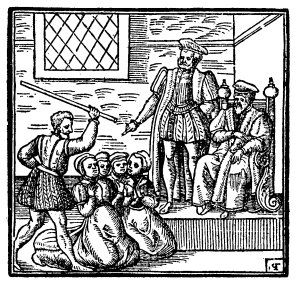
Even by the standards of his age, King James VI of Scotland, who later became James I of England, stood out as a deeply superstitious man, ruled by his obsession with the occult.
Before his reign, witchcraft persecutions had been rare in Britain. But that all changed in 1590 when James personally oversaw the trials by torture for around seventy individuals implicated in the North Berwick Witch Trials, the biggest Scotland had known. The witches’ alleged crime? Raising a storm which nearly sank James’s ship when he sailed home from Norway with his new bride, Anne of Denmark. Possibly dozens of accused witches were executed by burning at the stake, although the precise number is unknown.
In 1597 James published his book, Daemonologie, his rebuttal of Reginald Scot’s skeptical work, The Discoverie of Witchcraft, which questioned the very existence of witches. Daemonologie was an alarmist book, presenting the idea of a vast conspiracy of satanic witches threatening to undermine the nation.
In 1604, only one year after James ascended to the English throne, he passed his new Witchcraft Act, which made invoking spirits a crime punishable by execution.
James’s ideas on witchcraft were later popularised by Shakespeare’s play Macbeth, which had its premier performance at James’s court in 1606. For the first time in history, English drama depicted witches gathering in secret for their own malign rituals and scheming.
The weird sisters, hand in hand,
Posters by the sea and land,
Thus do go, about, about,
Thrice to thine, and thrice to mine,
And thrice again, to make up nine.
Peace, the charm's wound up.
(Macbeth, I,iii, 32-37)
According to Instruments of Darkness by James Sharpe, this terror of supposed witch covens was the driving factor mobilising 17th century witch hunts. Previously the belief in witches’ covens had been a Continental European concept, foreign to traditional British folk magic, practised by individuals, not collectives. No evidence exists that supposed witches in Early Modern Britain organised themselves into collectives, and nothing of the black mass can be traced to England at this time.
It wouldn't take long before life began to imitate James's and Shakespeare's dark fiction.
Six years on, in 1612, the King’s paranoid fantasy of satanic conspiracy, planted in the minds of local magistrates hoping to earn his favour, culminated in one of the key manifestations of the Jacobean witch-craze: the trials of the Lancashire Witches of Pendle, which resulted in the execution of seven women and two men. According to Thomas Potts's The Wonderfull Discoverie of Witches in the Countie of Lancaster, the official trial transcripts, the accused allegedly gathered "according to solemn appointment" at Malkin Tower on Good Friday, "with great cheer, merry company and much conference," and then plotted to blow up Lancaster Castle with gunpowder. As far-fetched as this scenario seems--where would a group of impoverished commonfolk even get hold of gunpowder--it fed directly into James' fears following the Gunpowder Plot of 1605.
James’s unfortunate legacy extends even into our age. The King James Bible, completed in 1611, saw the scriptures rewritten to further the King’s agenda. Exodus 22:18, originally translated as, “Thou must not suffer a poisoner to live,” became “Thou must not suffer a witch to live.”
Speaking of the Pendle Witches, local preparations for commemorating the 400th anniversary of the 1612 Lancashire Witch Trials are underway. Read more about it here.




